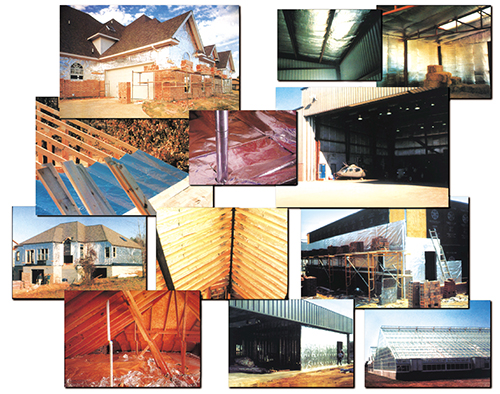Heating and Cooling Efficiency for Homes
Originating Technology/ NASA Contribution
Over 40 years ago, NASA developed Radiant Barrier technology to protect astronauts in the Apollo Program from temperatures that ranged from 250 °F above to 400 °F below zero Fahrenheit. This feat in temperature control technology enabled the astronauts to work inside the Apollo Command Module wearing short-sleeve shirts, with temperatures similar to those of a regular business office. The Radiant Barrier has been applied to virtually all spacecraft since then, including unmanned spacecraft with delicate instruments that need protection from temperature extremes. It is also applied to the astronauts’ space suits, protecting them during space walks.
Made of aluminized polymer film, the Radiant Barrier both bars and lets in heat to maintain a consistent temperature in an environment where ordinary insulation methods will not suffice. The aluminization of the material provides a reflective surface that keeps more than 95 percent of the radiated energy in space from reaching the spacecraft’s interior. In space suits, the thin and flexible material reflects the astronauts’ body heat back to them for warmth, while at the same time reflecting the sun’s radiation away from them to keep them cool. Using conventional insulation, a space suit would have required a 7-foot-thick protective layer.
Partnership
Since the 1970s, private industry has had the opportunity to apply Radiant Barrier technology to various commercial applications. This NASA-developed, public domain technology has been applied to energy conservation techniques for homes and offices, and even specialty applications such as candy wrapping, thermos bottles, windshield covers for automobiles, fire suits, space blankets for forest rangers, race cars, and refrigeration trucks to name just a few.
Product Outcome
Eagle Shield is a Radiant Barrier product that can be installed directly on top of existing ceiling insulation in ato reduce heating and cooling bills. Manufactured by Eagle Shield, Inc. , of San Ramon, California, the product consists of two sheets of 99.5 percent industrial grade aluminum adhered together and tri-laminated to a thermal break to create a two-sided reflector. It is perforated with tiny holes that allow moisture to pass through so it does not create a moisture barrier for existing insulation. According to the company, installation takes an average of 2 to 6 hours based on difficulty and accessibility of the attic, walls, and crawl space interiors. Eagle Shield Radiant Barrier Insulation is not mechanical, therefore it cannot break down and it requires no electrical or plumbing connections in the installation process.
Eagle Shield cuts heating and cooling costs by lowering the amount of heat transferred into ain the summer and out of a home in the winter. In the summer, heat waves generated by the home’s roof decking are reflected by the Radiant Barrier before they have the opportunity to be absorbed by the ceiling insulation, thereby keeping the home cooler. In the winter, the radiated heat waves from within the home are absorbed by the ceiling and conducted up through the insulation into the attic. In this case, the down-facing side of the Radiant Barrier reflects the radiant heat waves emitted from the insulation back down toward the living area instead of allowing them to simply escape into the attic. This process eliminates heat loss through the ceiling, saving heating costs.
In addition to lowering bills and increasing the comfort level of the home, the improved temperature control achieved by the Radiant Barrier product can potentially extend the life of the home’s heater and air-conditioning unit. Eagle Shield can also be applied to water heaters and ducts for improved energy efficiency. These applications show the continued benefits of Eagle Shield’s mission of “Bringing Space Age Technology Down to Earth.”

The cost-saving benefits of Eagle Shield, Inc.’s Radiant Barrier product extend to a variety of applications where heating and cooling efficiency is desired.













